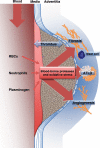Novel aspects of the pathogenesis of aneurysms of the abdominal aorta in humans
- PMID: 21037321
- PMCID: PMC3058728
- DOI: 10.1093/cvr/cvq337
Novel aspects of the pathogenesis of aneurysms of the abdominal aorta in humans
Abstract
Aneurysm of the abdominal aorta (AAA) is a particular, specifically localized form of atherothrombosis, providing a unique human model of this disease. The pathogenesis of AAA is characterized by a breakdown of the extracellular matrix due to an excessive proteolytic activity, leading to potential arterial wall rupture. The roles of matrix metalloproteinases and plasmin generation in progression of AAA have been demonstrated both in animal models and in clinical studies. In the present review, we highlight recent studies addressing the role of the haemoglobin-rich, intraluminal thrombus and the adventitial response in the development of human AAA. The intraluminal thrombus exerts its pathogenic effect through platelet activation, fibrin formation, binding of plasminogen and its activators, and trapping of erythrocytes and neutrophils, leading to oxidative and proteolytic injury of the arterial wall. These events occur mainly at the intraluminal thrombus-circulating blood interface, and pathological mediators are conveyed outwards, where they promote matrix degradation of the arterial wall. In response, neo-angiogenesis, phagocytosis by mononuclear cells, and a shift from innate to adaptive immunity in the adventitia are observed. Abdominal aortic aneurysm thus represents an accessible spatiotemporal model of human atherothrombotic progression towards clinical events, the study of which should allow further understanding of its pathogenesis and the translation of pathogenic biological activities into diagnostic and therapeutic applications.
Figures



References
-
- Sakalihasan N, Limet R, Defawe OD. Abdominal aortic aneurysm. Lancet. 2005;365:1577–1589. - PubMed
-
- Limet R, Sakalihassan N, Albert A. Determination of the expansion rate and incidence of rupture of abdominal aortic aneurysms. J Vasc Surg. 1991;14:540–548. - PubMed
-
- Kurvers H, Veith FJ, Lipsitz EC, Ohki T, Gargiulo NJ, Cayne NS, et al. Discontinuous, staccato growth of abdominal aortic aneurysms. J Am Coll Surg. 2004;199:709–715. - PubMed
-
- Anon. Mortality results for randomised controlled trial of early elective surgery or ultrasonographic surveillance for small abdominal aortic aneurysms The UK Small Anurysm Trial Participants. Lancet. 1998;352:1649–1655. - PubMed
-
- Hultgren R, Granath F, Swedenborg J. Different disease profiles for women and men with abdominal aortic aneurysms. Eur J Vasc Endovasc Surg. 2007;33:556–560. - PubMed
Publication types
MeSH terms
LinkOut - more resources
Full Text Sources
Other Literature Sources
Medical

